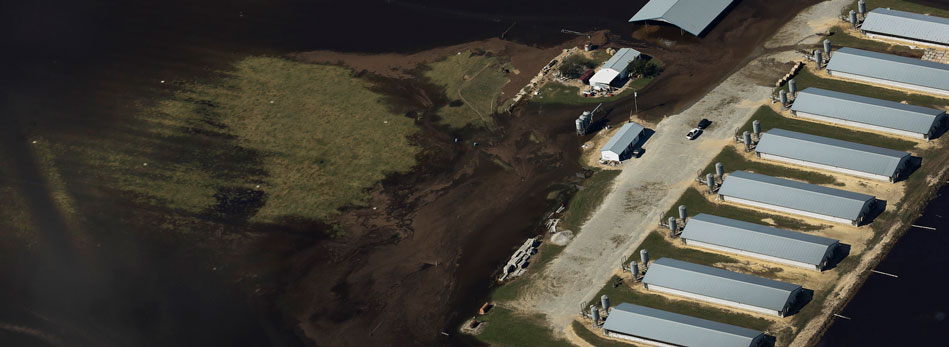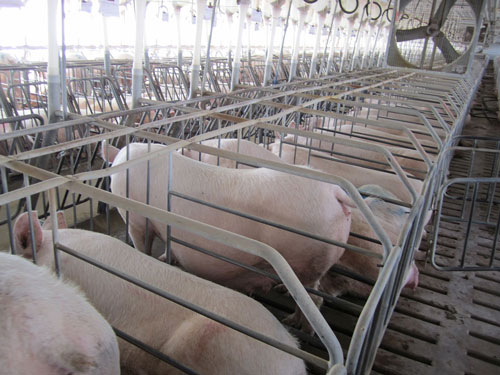
Environmental Impacts of Extreme Animal Confinement
Animal agriculture has changed dramatically in recent decades. From the practice of concentrated animal confinement on factory farms to the massive land use required to produce feed crops for livestock and the pollution inherent in poorly regulated waste management and slaughterhouses, the current U.S. food system is unsustainable and a leading contributor to environmental degradation.
Most of the 9 billion farmed animals in the United States are confined in concentrated animal feeding operations (CAFOs), which churn out meat, poultry, egg and dairy products at an unmanageable rate. The most extreme confinement practices — battery cages, gestation crates and veal crates — have been outlawed in a dozen states. Yet they largely continue as standard practices and are linked with poor animal welfare, risks to food and worker safety, air and water pollution, greenhouse gas emissions and threats to endangered species.
The Rise of Concentrated Animal Feeding Operations (CAFOs)
Since the 1950s U.S. meat and dairy production has more than doubled, while the number of operations has decreased by 80 percent [1]. As a result greenhouse gas emissions from the agricultural sector have rapidly increased, with carbon dioxide emissions increasing by 16.2 percent, methane emissions by 14.4 percent and nitrous oxide by 7.3 percent in the past 30 years [2]. Methane and nitrous oxide have as much as 36 and 298 times greater global warming potential, respectively, of CO2 over a 100-year period [3].
The most common environmental threats from these facilities include:
- Contamination of air, water, and land from nutrients, pathogens, heavy metals, pharmaceuticals, and ammonia;
- Overconsumption of groundwater resources;
- Harm to endangered or threatened species and habitats;
- Release of greenhouse gas emissions [4].
Along with the rise of CAFOs, emissions related to manure management have increased by 66 percent since 1990 [5]. Factory farms produced an estimated 13 times as much waste as the entire U.S. population in 2012 [6]. Unlike human waste, livestock waste is typically untreated and poorly managed.
The EPA estimates that pollution from CAFOs impairs 40 percent of rivers and streams in the United States [7].
Pigs and Gestation Crates

- With more than 70 million pigs populating the United States, and 5.36 million breeding sows, factory farms have implemented the practices of extreme confinement of mother pigs in gestation crates. These tight stalls prevent sows from turning around and contain no bedding, just slatted flooring for waste disposal.
- In 2014, 93 percent of annual hog production was on operations with at least 5,000 head (compared to 27 percent in 1994) [8]. This shift toward more concentrated facilities has resulted in increases in water and air contamination and environmental impairment [9].
- The increased concentration of hogs and breeding sows creates huge cesspools of waste that are currently disposed of by spraying onto surrounding lands. The massive amounts of waste generated in limited geographic areas leads to intensive air and water pollution and related health risks to surrounding communities and wildlife.
- For example, in Iowa, more than 10 billion gallons of liquid manure are applied to fields per year from the state’s more than 6,300 hog operations [10]. State records show 800 manure spills between 1996 and 2012, and 750 out of 1,378 tested waterways were found to be impaired [11].
Chickens and Battery Cages
- Most chickens spend their entire lives stocked in “battery cages,” in such high densities that they cannot exert their natural behaviors of nesting, roosting or even flapping their wings. Many chickens will die from disease and stress related to overcrowded conditions. However, the concentration of factory farming continues to encourage the use of these facilities.
- The production of poultry has shifted over recent decades toward more concentrated facilities [12]. The production of eggs has seen a related boom: Since 2011 top states have produced an additional 11.2 billion eggs in CAFO operations, including California, Ohio, Indiana, Missouri, Michigan, North Carolina and Texas [13]. The number of egg-laying hens increased by nearly 25 percent between 1997 and 2012, and the size of egg operations has grown by nearly 75 percent since 1997 [14].
- Battery cage facilities produce high levels of air contamination from ammonia and hydrogen sulfide as well as volatile organic compounds and dust originating from chicken feathers, bedding and chicken manure. Pollutants spread from the chicken cages and fields to waterways, critical habitat areas, and local community houses, churches and schools.
- In addition to large amounts of pesticide and pharmaceutical residues, bacteria, viruses, pathogens, parasites, protozoa, heavy metals and other trace elements [15], poultry waste is particularly high in toxic nutrients, and yet is usually untreated, and stored and land-applied [16,17]. Over 90 percent of poultry waste is disposed of through land applications [18]. Erosion, non-agronomic waste applications, and rain can cause it to reach surface and groundwaters [19].
- Release of these pollutants may result from intentional discharge, operation, maintenance, management and/or operation design problems [20]. Waste-management systems can have spills, leaks, accidental discharges and reach surface water and/or groundwater [21].
- The EPA has noted that rain falling on dry poultry manure left outside uncovered will likely transport pollutants into nearby soil, causing groundwater pollution and contaminating surface waters [22].
Calves and Veal Crates
- Calves are removed from their mothers to prevent suckling and chained in crates — 22 inches by 54 inches — without the ability to move or turn around. Preventing the animals from moving keeps their muscles anemic, and the calves are fed formula instead of mother’s milk.
- Calf waste is distributed either through deep pit storage or flush. The floor of the crate is composed of slats directly above a storage pit or flush alley. This flooring does not adequately allow feces and urine to pass through, and animals end up standing and sleeping in their own feces, leading to the contraction of parasites, a virus or harmful bacteria. Diarrhea from dehydration is common and sometimes fatal [23].
- The majority of veal operations use large volumes of water to flush manure from storage pits to lagoons. The remaining operations store manure in a large pit beneath the shed, which uses less water but results in a higher concentration of nutrients.
- Calves are slaughtered between 4 to 5 months of age. But calves younger than 4 months are not included in greenhouse gas emission estimates, so the climate impact of veal production is unaccounted for [24].
Lack of Environmental Protection
Despite 40 years of Clean Water Act implementation, the EPA still lacks data about where the nation’s CAFOs are located and which facilities discharge pollutants into waterways without required permits [25].
The EPA states 40 percent of CAFOs are regulated under National Pollutant Discharge Elimination Systems (NPDES) while 75 percent discharge as a result of “standard operational profiles” [26].
Despite major gaps in information and regulation, the EPA abandoned its only effort in decades to fill these gaps by developing a national inventory, under CAFO industry pressure [27]. This failure by EPA to develop or maintain a CAFO inventory has meant that states must identify CAFOs and determine which are subject to regulation with little guidance or oversight from EPA.
The lack of federal oversight leaves communities bearing the burden of the environmental impacts of industrial livestock production. Lawmakers can take steps to protect air, water and wildlife by banning the most extreme forms of confinement and working to close regulatory loopholes at the state and federal levels.
References
[1] APHIS, USDA. Overview of U.S. Livestock, Poultry and Aquaculture Production in 2015. https://www.aphis.usda.gov/animal_health/nahms/downloads/Demographics2015.pdf
[2] EPA, Draft Inventory of U.S. Greenhouse Gas Emissions and Sinks 1990-2017. https://www.epa.gov/ghgemissions/draft-inventory-us-greenhouse-gas-emissions-and-sinks-1990-2017
[3] EPA, Understanding Global Warming Potentials. https://www.epa.gov/ghgemissions/understanding-global-warming-potentials. Accessed 4/3/2019.
[4] EPA Literature Review, at 1-3.
[5] EPA, Draft Inventory of U.S. Greenhouse Gas Emissions and Sinks 1990-2017. https://www.epa.gov/ghgemissions/draft-inventory-us-greenhouse-gas-emissions-and-sinks-1990-2017
[6] EPA, National Pollutant Discharge Elimination System (NPDES) Concentrated Animal Feeding Operation (CAFO) Reporting Rule, Proposed Rule, 76 Fed. Reg. 65431, 65433 (Oct. 21, 2011); Food & Water Watch, Factory Farm Nation 2015 Edition 3 (2015), http://www.foodandwaterwatch.org/sites/default/files/factory-farm-nation-report-may-2015.pdf.
[7] EPA, 2000 National Water Quality Inventory Report to Congress. https://www.epa.gov/waterdata/national-water-quality-inventory-report-congress
[8] Overview of the United States Hog Industry, released October 29, 2015 by the National Agricultural Statistics Service (NASS), Agricultural Statistics Board, USDA http://usda.mannlib.cornell.edu/usda/current/hogview/hogview-10-29-2015.pdf.
[9] Pew Commission on Industrial Farm Animal Production, “Putting Meat on the Table: Industrial Farm Animal Production in America” (2008), http://www.pcifapia.org/_images/PCIFAPFin.pdf.
[10] Brian Bienkowski, “My number one concern is water,” Environmental Health News (Nov. 14, 2017), http://www.ehn.org/water-pollution-hog-farming-2504466831.html.
[11] Id.
[12] See generally Pew Charitable Trusts, The Business of Broilers (2013), available at http://www.pewtrusts.org/~/media/legacy/uploadedfiles/peg/publications/report/businessofbroilersreportthepewcharitabletrustspdf.pdf [hereinafter The Business of Broilers]; U.S. Environmental Protection Agency (EPA), Literature Review of Livestock and Poultry Manure, EPA 820-R-13-002, 1 (July 2013).
[13] USDA, National Agricultural Statistics Service. 2018. https://quickstats.nass.usda.gov/
[14] Food and Water Watch. Factory Farm Nation: 2015 Edition. https://www.foodandwaterwatch.org/insight/factory-farm-nation-2015-edition
[15] Exhibit 7 - EPA, Detecting and Mitigating the Environmental Impacts of Fecal Pathogens Originating from Confined Animal Feeding operations: Review, EPA/600/R-06/021, 1-3 (Sept. 2005) (citations omitted); see also Exhibit 4 - 68 Fed. Reg. at 7235-36.
[16] Exhibit 47 - J.A. Stingone & S. Wing, Poultry litter incineration as a source of energy: reviewing the potential for impacts on environmental health and justice, 1(1) NEW SOLUTIONS 27-47, 33 (2011) (referencing International Agency for Research on Cancer, Monographs on the Evaluation of Carcinogenic Risks to Humans: Some Drinking Water Disinfectants and Contaminants, Including Arsenic (2004); Exhibit 48 - M. Vahter, Health effects of early life exposure to arsenic, 102 BASIC & CLINICAL PHARMACOLOGY & TOXICOLOGY 204-211 (2008); Exhibit 49 - C.D. Kozul et al., Low-dose arsenic compromises the immune response to influenza A infection in vivo, 117 ENVIRONMENTAL HEALTH PERSPECTIVES 1441-1447 (2009).
[17] Exhibit 4 – EPA 2003 Final Rule at 7235-36.
[18] Exhibit 55 - PEW COMMISSION ON FARM ANIMAL PRODUCTION, ANTIMICROBIAL RESISTANCE AND HUMAN HEALTH 31 (2008) (citations to USDA resources omitted.)
[19] See, e.g., Exhibit 8 - NRCS AWMFH Ch. 3 “Agricultural Wastes and Water, Air, and Animal Resource”; Exhibit 56 - NRCS Conservation Practice Standard Code 590 “Nutrient Management” (Jan. 2012).
[20] See, e.g., Exhibit 51 to 54 - NRCS AWMFH Ch. 2 (Planning Considerations) (Exhibit 51); Ch. 7 (Geologic and Groundwater Considerations) (Exhibit 52); Ch. 8 (Siting Agricultural Waste Management Systems) (Exhibit 53); Ch. 9 (Agricultural Waste Management Systems) (Exhibit 54).
[22] Id. NRCS AWMFs specifically suggest producers plan for such considerations.
[23] Exhibit 4 – EPA 2003 Final Rule at 7192; see also Exhibit 8 - AWMFH Ch. 3 (Agricultural Wastes and Water, Air, and Animal Resources) at 3-17 (discussing pathways to pollution); Exhibit 56 - NRCS AWMFH Ch. 9 (Agricultural Waste Management Systems) at 9-23.
[24] EPA, “Non-water Quality Impact Estimates for Animal Feeding Operations.” (December 2002).
[25] EPA, Draft Inventory of U.S. Greenhouse Gas Emissions and Sinks 1990-2017. https://www.epa.gov/ghgemissions/draft-inventory-us-greenhouse-gas-emissions-and-sinks-1990-2017
[26] Proposed CAFO Reporting Rule, 76 Fed. Reg. at 65436.
[27] National Pollutant Discharge Elimination System (NPDES) Concentrated Animal Feeding Operation (CAFO) Reporting Rule, Withdrawal, 77 Fed. Reg. 42679 (Jul. 20, 2012).
